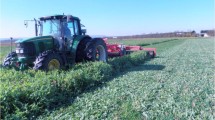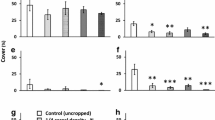Abstract
Weed species within arable farming systems act as a source of food and provide habitat for various taxa at higher trophic levels. Using field experiments in winter wheat, we investigated whether selective herbicides can be used as a potential tool for sustaining beneficial, less competitive weed species and rare species of high conservation value while controlling highly competitive weed species. We tested three selective herbicides with different active ingredients (amidosulfuron + iodosulfuron, fluroxypyr, mecoprop-P) at two application rates. We analysed cover of selected focal species (Centaurea cyanus and Papaver rhoeas) as well as weed species richness, winter wheat yield and weed community composition as influenced by herbicide treatments. Herbicide treatments involving fluroxypyr generally allowed for the selective retention of the regionally threatened weed species C. cyanus and P. rhoeas as a beneficial species of high value for associated trophic level and provided considerable control of the competitive species G. aparine. Herbicide treatments significantly affected weed species composition. The PRC method clearly showed the time-dependent herbicide treatment effects on weed community composition and allowed an estimate of the variance in species composition that is explained by the herbicide treatments. Our results indicated that applying selective herbicides can provide a feasible option for in-crop management of weed diversity by retention of beneficial or rare weed species occurring at moderate densities and control of highly-competitive weeds. However, weed control strategies must be tailored to site-specific conditions to account for increased abundance of competitive species.
Zusammenfassung
Unkräuter können Ressource und Habitat für nützliche Arten höherer trophischer Ebenen bereitstellen. Anhand von Feldversuchen in Winterweizen wurde der Einsatz selektiver Herbizide zur Förderung nützlicher, weniger konkurrenzstarker und seltener Unkrautarten bei gleichzeitiger Kontrolle von konkurrenzstarken Unkrautarten untersucht. Es wurden drei selektive Herbizide (Amidosulfuron + Iodosulfuron, Fluroxypyr, Mecoprop-P) anhand von zwei Aufwandmengen getestet. Dabei wurden der Deckungsgrad der untersuchten Arten (Centaurea cyanus und Papaver rhoeas), die Gesamtartenzahl, der Winterweizenertrag sowie die Zusammensetzung der Unkrautpopulation analysiert. Die Applikation von Fluroxypyr erwies sich als geeignet für sowohl die Erhaltung der regional bedrohten Art C. cyanus und der Art P. rhoeas, die eine hohe Bedeutung für höhere trophischen Ebenen aufweist, als auch für die Bekämpfung der konkurrenzstarken Art G. aparine. Die Herbizidbehandlungen hatten einen signifikanten Einfluss auf die Zusammensetzung der Unkrautpopulationen. Die multivariate Principal Response Curve (PRC) Methode veranschaulichte die Auswirkungen der Herbizidbehandlungen auf die Populationszusammensetzung in Abhängigkeit von der Versuchslaufzeit und ermöglichte zudem eine Abschätzung der durch die Herbizidbehandlungen erklärten Varianz. Die Ergebnisse zeigen, dass selektive Herbizide eingesetzt werden können, um seltene oder nützliche Unkrautarten zu erhalten und konkurrenzstarke Arten zu bekämpfen. Allerdings sollte die jeweilige Behandlung situationsspezifisch an die vorhandenen Unkrautarten angepasst werden um ein erhöhtes Aufkommen von konkurrenzstarken Arten zu vermeiden.
Similar content being viewed by others
References
Aebischer, N.J., 1997: Effects of cropping practices on d eclining farmland birds during the breeding season. In: British Crop Protection Council (ed.): Proceedings of the Brighton Crop Protection Conference — Weeds 1997, Brighton, UK, pp. 915–922. British Crop Protection Council, Hampshire.
Asteraki, E.J., B.J. Hart, T.C. Ings, W.J. Manley, 2004: Factors influencing the plant and invertebrate diversity of arable field margins. Agr. Ecosyst. Environ. 102, 219–231.
Chamberlain, D.E., R.J. Fuller, R.G.H. Bunce, J.C. Duckworth, M. Shrubb, 2000: Changes in the abundance of farmland birds in relation to the timing of agricultural intensification in England and Wales. J. Appl. Ecol. 37, 771–788.
Davies, K., 2003: Winter wheat and barley: the integrated management of broad-leaved weeds and meadow-grass. Scottish Agricultural College (SAC) Technical Note T540.
de Snoo, G.R., 1995: Unsprayed field margins: implications for environment, biodiversity and agricultural practice. PhD thesis, Leiden University, The Netherlands.
de Snoo, G.R., R. Luttik, 2004: Availability of pesticide-treated seed on arable fields. Pest Manag. Sci. 60, 501–506.
DEUTSCHER Wetterdienst, 2008: www.dwd.de.
Derksen, D.A., A.G. Thomas, G.P. Lafond, H.A. Loeppky, C.J. Swanton, 1995: Impact of post-emergence herbicides on weed community diversity within conservation-tillage systems. Weed Res. 35, 311–320.
Fitzgerald, J.D., M.G. Solomon, 2004: Can flowering plants enhance numbers of beneficial arthropods in UK apple and pear orchards? Biocontrol Sci. Techn. 14, 291–300.
Free, J.B., 1993: Insect pollination of crops. Academic Press, London.
Frei, G., C. Manhart, 1992: Nützlinge und Schädlinge an künstlich angelegten Ackerkrautstreifen in Getreidefeldern. In: Nentwig, W., H.-M. Poehling (eds.): Agrarökologie 4. Hauptverlag, Bern, Stuttgart.
Håkansson, S., 2003: Weeds and weed management on arable land: an ecological approach. CABI Publishing, Oxon, UK.
Hawes, C., A.J. Haughton, J.L. Osborne, D.B. Roy, S.J. Clark, J.N. Perry, P. Rothery, D.A. Bohan, D.R. Brooks, G.T. Champion, A.M. Dewar, M.S. Heard Woiwod, R.E. Daniels, M.W. Young, A.M. Parish, R.J. Scott, L.G. Firbank, G.R. Squire, 2003: Responses of plants and invertebrate trophic groups to contrasting herbicide regimes in the Farm Scale Evaluations of genetically modified herbicide-tolerant crops. Philos. T. Roy. Soc. B 358, 1899–1913.
Hyvönen, T., E. Ketoja, J. Salonen, 2003: Changes in the abundance of weeds in spring cereal fields in Finland. Weed Res. 43, 348–356.
Jones, N.E., B. Smith, S.K. Cook, J.M. Holland, 2007: Manipulate within crop agronomy to increase biodiversity: Integrated crop management strategies. In: The SAFFIE Project Report, ADAS, pp. 108–267. Boxworth, UK.
Jones, N.E., B.M. Smith, 2007: Effects of selective herbicide treatments, row width and spring cultivation on weed and arthropod communities in winter wheat. Aspects Appl. Biol. 81, 39–46.
Jongepierova, I., J. Mitchley, J. Tzanopoulos, 2007: A field experiment to recreate species rich hay meadows using regional seed mixtures. Biol. Conserv. 139, 297–305.
Kudsk, P., J.C. Streibig, 2003: Herbicides — a two-edged sword. Weed Res. 43, 90–102.
Lutman, P.J.W., 2005: Sustainable weed management: development of techniques to balance biodiversity benefits with retention of yield. Research Project Final Report, UK Government.
Lutman, P.J.W., G.W. Cussans, K.J. Wright, B.J. Wilson, G. Mcn Wright, H.M. Lawson, 2002: The persistence of seeds of 16 weed species over six years in two arable fields. Weed Res. 42, 231–241.
Maccherini, S., M. Marignani, P. Castagnini, P.J. van den Brink, 2007: Multivariate analysis of the response of overgrown semi-natural calcareous grasslands to restorative shrub cutting. Basic Appl. Ecol. 8, 332–342.
Marshall, E.J.P., V.K. Brown, N.D. Boatman, P.J.W. Lutman, G.R. Squire, L.K. Ward, 2003: The role of weeds in supporting biological diversity within crop fields. Weed Res. 43, 77–89.
Marshall, E.J.P., A.C. Moonen, 2002: Field margins in northern Europe: their functions and interactions with agriculture. Agr. Ecosyst. Environ. 89, 5–21.
Perju, T., I. Moldovan, 1991: Entomofauna of Centaurea species with a view to biological control. Buletinul Institutului Agronomic Cluj Napoca. Seria Agricultura si Horticultura 45, 73–84.
Pywell, R.F., E.A. Warman, T.H. Sparks, J.N. Greatorex-Davis, K.J. Walker, W.R. Meek, C. Carvell, S. Petit, L.G. Firbank, 2004: Assessing habitat quality for butterflies on intensively managed farmland. Biol. Conserv. 118, 313–325.
R Development C ore T eam, 2007: R: A language and environment for statistical computing. R Foundation for Statistical Computing. ISBN 3-900051-07-0, URL http://www.R-project.org.
Russell, E.P., 1989: Enemies Hypothesis: A review of the effect of vegetational diversity on predatory insects and parasi-toids. Environ. Entomol. 18, 590–599.
Smith, B.M., J.M. Holland, N.E. Jones, S. Moreby, A.J. Morris, S.E. Southway, 2009: Enhancing invertebrate food resources for skylarks in cereal ecosystems: how useful are in-crop agri-environment scheme management options? J. Appl. Ecol. 46, 692–702.
Storkey, J., D.B. Westbury, 2007: Managing arable weeds for biodiversity. Pest Manag. Sci. 63, 517–523.
Ter Braak, C.J.F., P. Smilauer, 2002: CANOCO Reference Manual and CanoDraw for Windows User’s Guide: Software for Canonical Community Ordination (version 4.5). Microcomputer Power, Ithaca, New York.
Torra, J., J.T. Gonzalez-Andujar, J. Recasens, 2008: Modelling the population dynamics of Papaver rhoeas under various weed management systems in a Mediterranean climate. Weed Res. 48, 136–146.
Van Den Brink, P.J., C.J.F. Ter Braak, 1999: Principal response curves: Analysis of time-dependent multivariate responses of biological community to stress. Environ. Toxicol. Chem. 18, 138–148.
Weiss, E., C. Stettmer, 1991: Unkräuter in der Agrarlandschaft locken blütenbesuchende Nutzinsekten an. Hauptverlag, Bern, Stuttgart.
Westbury, D.B., B.A. Woodcock, S.J. Harris, V.K. Brown, S.G. Potts, 2008: The effects of seed mix and management on the abundance of desirable and pernicious unsown species in arable buffer strip communities. Weed Res. 48, 113–123.
Wilson, P.J., 2007: The Status of Centaurea cyanus in Britain. Unpublished.
Author information
Authors and Affiliations
Corresponding author
Rights and permissions
About this article
Cite this article
Ulber, L., Steinmann, HH. & Klimek, S. Using selective herbicides to manage beneficial and rare weed species in winter wheat. J Plant Dis Prot 117, 233–239 (2010). https://doi.org/10.1007/BF03356366
Received:
Accepted:
Published:
Issue Date:
DOI: https://doi.org/10.1007/BF03356366




